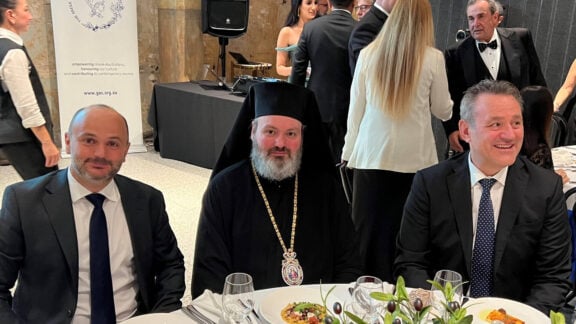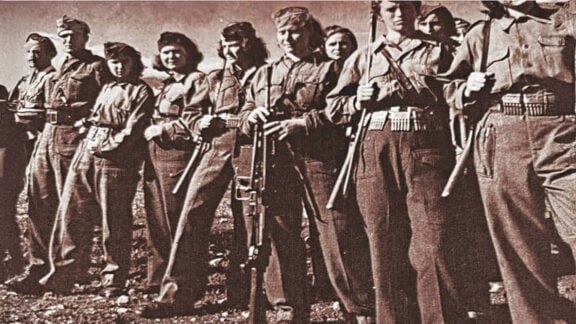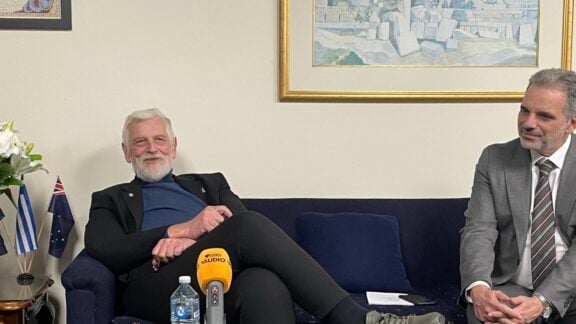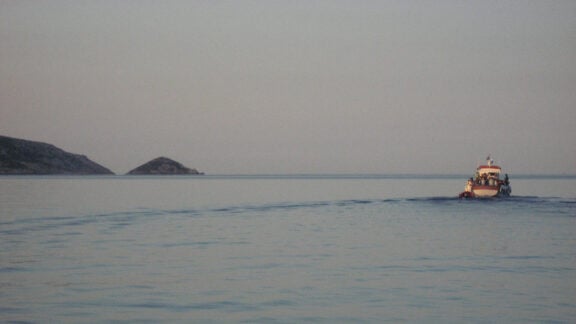His name lived on as members of the surviving family, which hailed from Krithia on the Gallipoli Peninsula, named their children in his honour.
Just over two months ago, his great nephew Steve (Stratos) Karakitsos, whose father is named Fotis, decided to try out an online ancestry site to see if it could shed some light on what happened to Fotios. To his surprise, it provided the answers that had eluded the family for generations.
“It was about two months ago and advertisement for an offer from Ancestry DNA regarding military records appeared on my computer screen. I inserted my great uncle’s name and something came up in French military records.”
He was recorded as “Fostios Karakitsas” who had enlisted in the French Foreign Legion in 1918. He was wounded in battle at a hill called La Montagne de Paris (the Mountain of Paris), to the west of the city Soissons. He died of his wounds on 2 June, 1918, at the Ambulance (a casualty clearing station).
He lay in a First World War military cemetery and he had been assigned a Muslim headstone. So Steve began to piece together what may have happened. He enlisted the help of French local historian and educator, Pierre Seillier, who communicated with the War Graves Office to ensure that his final resting place was marked with a cross.

At the turn of the last century, the Karakitsos family were respected inhabitants of the village of Krithia on the southern end of the Gallipoli Peninsula. About 450 Greek families lived in the village. According to French documents, Fotis was born on 15 March, 1881. His father, Charalambos, was a wealthy landowner with 2,000 olive trees. Fotios had a brother, Dimitris, who was Steve’s grandfather.
War was soon to determine the ancient community’s fate. In 1912 (during the First Balkan War) the Greek inhabitants successfully resisted a Turkish siege of their village.
Following the outbreak of the First World War, in October 1914, a Turkish military mission arrived at the village.
“Turkish soldiers with fixed bayonets surrounded the village and forced the evacuation of each house in turn. Then, under the eyes of their officers, they seized everything they could lay their hands on. Stripped of everything they possessed, the inhabitants in despair had to seek refuge in Madytos,” said Steve quoting official documents. Their forced removal from their ancestral homes along with 15,000 other Greeks on the Gallipoli Peninsula was a prelude to the events culminating in 1922.

The sequence of events becomes confusing. Dimitris and possibly Fotios were dragooned to act as stretcher bearers for the Ottoman troops in the fighting that ensued as Krithia became a key target.
In the First Battle of Krithia (28 April, 1915) French and British forces fought the First Battle of Krithia (28 April, 1915) with ANZAC forces being involved in the second Battle of Krithia (6 May). Each time, they were repelled with great loss on both sides.
“I see the two brothers as stretcher bearers for the Ottoman troops at Gallipoli. I don’t know if Fotios also fought under the Turks or whether he fought under Allies since there are reports of Krithian siblings having been recruited by the opposing forces,” said Steve.
Evidence confirms that the Karakitsos family alongside other Krithians returned to the Gallipoli Peninsula for a brief time after the war when it was under the control of French forces.
“My godmother’s mother Katerina Kalathas née Saflekos, would play amongst the French troops who would give the Greek children biscuits and also taught her the French national anthem which she would recite with a flawless French accent. This is contrary to the history books which state that the Greeks had all left prior to involvement by the foreign powers.”
“More than likely this would have taken place after the French firmly established themselves on the Gallipoli Peninsula after 1918, probably 1919, when most of Eastern Thrace, inclusive of the Gallipoli Peninsula was ceded to Greece. If this occurred at the start of the war, this is contrary to the history books which state that the Greeks had left before involvement by the foreign powers,” Statos said.
Of the immediate family, Steve said: “only his (Fotios’) mother, Maria, and his brother, Dimitrios (who was recruited by the Turks), survived the carnage and were forced to abandon their ancestral homeland. The whereabouts of his two sisters and their father, Charalambos, being from the wealthiest family of Krithia, are unknown.”
“I understand that Fotios’ brother Dimitrios, my grandfather, left with his personal boat and sailed to the Greek island of Syros where many others from Krithia were located (most were taken to Corfu including his future wife Konstantina Kaklamanos) until they were reassembled to the outskirts of Thessaloniki around a year later.
The survivors had joined the refugee streams to Greece, where a village named Krithia was established north of Thessaloniki. Krithia in Gallipoli was badly damaged in the Gallipoli campaign. The village was settled with Turks from Romania and was renamed Alcitepe.
In 1954, Dimitrios’ son, Fotis (and Steve’ father) came to Australia on board the Kyrenia. Dimitrios and other members of the family were to follow suit in the ensuing years.
The family lost track of Great Uncle Fotis and it is from this point on that the records that Steve uncovered recently where the gaps in his story have finally been filled.
Steve Karakitsos communicated by email with Mr Seillier who is dedicated to keeping alive the role of Australian forces in the Battle of Frommeles. It was Mr Seillier who informed him that “Fostios Karakitsas” was a private in the French Foreign Legion regiment Régiment de March de la Légion de Etrangère (RMLE), one of the most decorated and most famous in the French army.

“It seems Fostio was voluntary enlisted in the French Foreign Legion early in 1918. … He enlisted in Marseilles because it was one of the main places to enlist in the French Foreign Legion when you came from the Mediterranean zone. … But it is not sure he lived in Marseille before enlistment. … Nothing about his previous life. The only document available in France is his military certificate of death, he is listed as ‘Died of Wound’ and ‘Dead for France’,” Mr Seillier wrote.
He wrote that Fotios may have been wounded in action before the Mountain of Paris.
“On 29 May (1918), the Moroccan division and the RMLE were transported by truck to west of Soissons, which had just fallen into enemy hands… The (German) attack begins in the early morning after a brief but violent artillery barrage. Clearly outnumbered, the enemy succeeded in gaining a foothold in the Legion’s positions. Forced to save their ammunition, the legionnaires lost 47 killed, 219 wounded and 70 missing in two day combat. … The RMLE succeeded in maintaining its positions and blocking the German advance in their sector.,” Mr Seillier wrote.
“Until May 31, on a front of 5km, the marching regiment of the Foreign Legion, composed among other of Armenian volunteers, the 3rd and 10th BCP hold alone for six days and six nights …” wrote Mr Seillier.
While it is not clear when he was wounded, Fotios Karakitsas, died at a casualty clearing station on 2 June, 1918. It is also not clear why he was buried as a Muslim.
Thanks to Steve and Mr Sieller’s efforts, the French Grave Office agreed to replace the headstone with a cross.
With the encouragement of Lambis Eglezos, co-founder of Friends of the 15th Brigade an organisation dedicated to restoring the dignity of those who died predominantly in World War One, Steve is looking to enlist the services of a Greek Orthodox priest in France to rededicate his great uncle’s grave.







